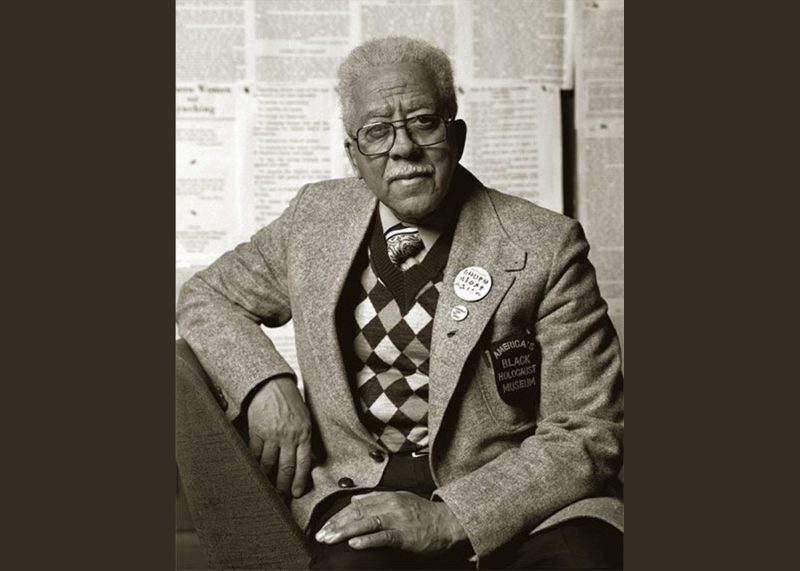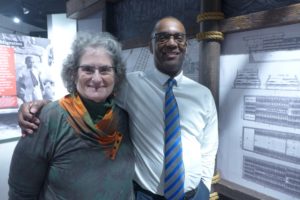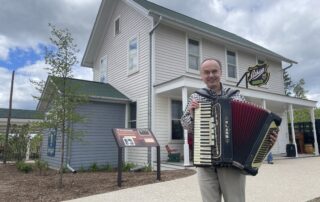(Editor’s note and update: American’s Black Holocaust Museum is reopening at its new location on Feb. 25, 2022.)
In Milwaukee’s historic Bronzeville neighborhood, a museum is resurrecting.
America’s Black Holocaust Museum was founded in 1988, closed in 2008, and transformed into an online museum. Now, a new physical museum stands, waiting to welcome visitors from around the world. Before understanding the museum’s history and purpose, it helps to get to know its founder, Dr. James Cameron. He’s supposedly the only person in the United States to survive a lynching.
He Heard A Voice
James Cameron was born in La Crosse, Wisconsin on February 25, 1914. La Crosse was a hub for master barbers at the time and his father, who was a barber, moved there to hone his craft. The family eventually left, moved around the country, and settled in Marion, Indiana. It was there that Cameron would experience the most horrific and influential experience of his life.
On August 6, 1930, 19 year-old Abram Smith and 18 year-old Thomas Shipp stopped by Cameron’s house and asked him if he wanted to go for a ride.
“Cameron was 16 at the time,” said America’s Black Holocaust Museum Head Griot Reggie Jackson. “After they got in the car, they told him that they were going to go out to a lover’s lane and rob somebody to get some money to get another car. He reluctantly stayed with them.”
They came across a couple in a car, Claude Deeter and Mary Ball.
“[Abram and Thomas] gave him a gun and Cameron said, ‘I don’t want to have anything to do with this,’” said Jackson. “But peer pressure got the best of him. As soon as he opened the door, he recognized Claude Deeter. It was one of his best friends and a guy that gave him good tips at a shoeshine parlor. So, he gave the gun back to Abe and Tommy and he took off running.”
In the distance, Cameron heard gunshots. Deeter had been killed.
The police soon arrested Smith, Shipp, and Cameron, accusing them of murder.
“Eventually, people came from far and wide from neighboring communities to get these boys out of the jail and do something to them,” said Jackson.
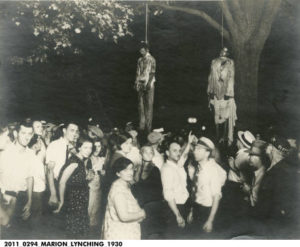
The lynching of Abram Smith and Thomas Shipp in Marion, Indiana in 1930. This photo inspired the song, “Strange Fruit.” (Photo courtesy of Indiana Historical Society, P0411)
The angry mob dragged Shipp and Smith out of the jail and hung them. A photograph of the tragedy inspired Abel Meeropol to write the song, “Strange Fruit,” which was popularized by Billie Holiday and Nina Simone.
Cameron recalled what happened next on WHYY’s Fresh Air in 1994.
“They began to yell for me like a favorite basketball or football player. They said, ‘We want Cameron. We want Cameron. We want Cameron.’ And as the priest cleared the path, I looked over into the faces of people as they were beating me along the way up to the tree.
“I was pleading for some kind of mercy, looking for a kind face. But I could find none. And they got me up to the tree and someone said, ‘Where’s the rope?’ They got a rope and they put it around my neck and they began to push me under the tree and that’s when I prayed to God. I said, ‘Lord, have mercy and forgive me my sins.’ I was ready to die.”
But then, Cameron heard a voice.
“The voice said, ‘Take this boy back. He had nothing to do with any killing,’” said Cameron.
It became silent. The crowd miraculously let Cameron go and he staggered back to the jail.
“People would always ask him how he survived a lynching,” said Jackson. “He would tell the story about the voice he heard. There were people who doubted that there was a voice and he would always answer it the same way: ‘For those of us who believe in God, no explanation is necessary. For those of us who don’t believe in God, no explanation is possible.’
Cameron was charged as an accessory before the act of manslaughter and was sent to prison for four years. In 1993, he was pardoned by Indiana’s governor.
Sharing His Story
While in prison, Cameron spent his time reading and learning to type.
“When he came out of jail, he decided that he wanted to do something very worthwhile with his life because as far as he was concerned, God had saved him for that,” said Fran Kaplan, curator of America’s Black Holocaust Virtual Museum.
He spent decades working on his memoir, “A Time of Terror: A Survivor’s Story.”
“After he got out of jail, he went back to live within 30 miles of that tree. He raised a family there and went to the town where he had been lynched and interviewed the witnesses,” said Kaplan.
Over the years, Cameron worked in factories, started a business, got married and had children.
“He was an active, very early Civil Rights pioneer. He and his wife and children desegregated the movie theater in the [Indiana] town he lived in,” said Kaplan. “They sat in the white section more than once to desegregate it. The black folks were supposed to sit in the crow’s nest up in the gallery and the Cameron family refused to do that.”
He also worked with the NAACP and was Indiana’s Director of Civil Liberties.
Moving to Milwaukee
In 1952, the Cameron family had to leave Indiana after a series of death threats. Their initial plan was to move to Canada, but instead, they landed in Milwaukee.
“At that time, the Bronzeville business district was booming,” said Jackson. “It had many black-owned businesses. He fell in love with the city of Milwaukee.”
Over the years, Cameron had acquired things from people, like Ku Klux Klan outfits, products with racist images, and a piece of the rope that had been used during the Marion lynching in 1930. It was a visit to Yad Vashem, the World Holocaust Remembrance Center in Israel, that inspired him to do something with those artifacts.
“While [Cameron and his wife] were standing there, they were both in tears,” said Jackson. “He turned his wife, Virginia, and said, ‘Virginia we need a museum like this in America to tell what happened to black people and all of those freedom-loving whites that have been with us along this journey.’ That’s where the idea came from to start the museum,” said Jackson.
At age 74, Cameron founded America’s Black Holocaust Museum. It eventually found its home in an old boxing gym in the Bronzeville neighborhood. The city sold him the building for $1.
“He felt very strongly that the only way to [heal the country] was to be honest about the nation’s history,” said Jackson. “To share those ugly parts of history, as well as the positive things. We could begin to have conversations about how we get past those things, begin to build coalitions, and build relationships across racial groups. It would help us move towards the healing process, focusing on reconciliation and repair. All of those things were part of his reasoning for starting the museum,” said Jackson.
The mission was to commemorate what happened to people who were captured in Africa and the impacts of slavery, Jim Crow, and racism in the 400 years that followed. It’s a part of American history that is often glazed over or not included in school history classes.
“The museum is designed to help people. It’s not designed to hurt anybody. It’s not designed to make people feel uncomfortable,” said Jackson.
A Museum Resurrected
America’s Black Holocaust Museum closed in 2008. This followed Cameron’s death in 2006 at age 92. The museum lives on as a virtual online museum. Then in 2017, organizers broke ground for a new physical museum.
The goal was to reopen in Fall 2018, but organizers ran into funding issues. The building is standing, displays are built, but organizers say they need more money. Jackson says they want to raise enough to establish an endowment, so they don’t run into financial issues down the line. Currently, Milwaukee County Executive Chris Abele is matching all donations to the museum up to $100,000.
Kaplan said the museum is needed more than ever before.
“This country is now is in a process of truth and reconciliation. People are looking to change what’s happening in race relations in this country. Dr. Cameron was way out ahead of this because he emphasized that the truth would set you free,” said Kaplan.
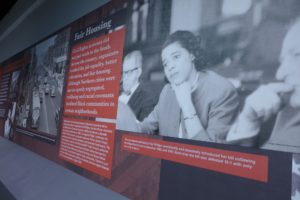
Displays at the new America’s Black Holocaust Museum feature Milwaukee legends, like Vel Phillips. (Maureen McCollum/WPR)
Jackson said the museum can play a role in healing race relations.
“Even though we’re very divided as a nation right now, I think that we’re beginning to see a lot more people that are reflecting on this past. We need to begin to have these conversations because you can’t move past any traumatic events without eventually talking about them in a very open and honest way,” said Jackson.
Cameron continues to inspire and guide the work taking place at the museum.
“Dr. Cameron was a loving person,” said Jackson. “This man who survived a lynching at the age of 16, who was forced to witness a lynching at the age of eight, found a way to not be a hateful person. He found a way to take tragic events that happened in his life and use that experience, those emotions, to grow into a person who wanted to make the world better for everybody.”
“Hatred is a disease that eats into the core of whole body and destroys it from within. But if you have love in your heart, you can blossom as the sun shines every day.”- Dr. James Cameron.
==
SONG: “Strange Fruit” by Lara Downes
